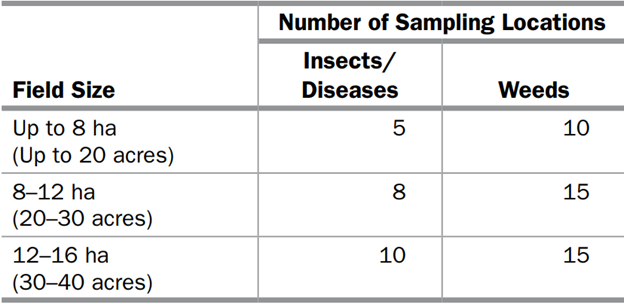When scouting for insects that move too quickly in the canopy to be spotted or counted, or insects which are difficult to detect, it may be beneficial to use a drop cloth, insect traps or a sweep net to collect and count them.
Using a Drop Cloth
Spread a white drop cloth on the ground between two rows of crop. Pull the crop over the cloth and shake vigorously so that any insects on the plant are dislodged and dropped onto the cloth. The insects can then be identified and counted.
Using an Insect Trap
Insect traps can be useful for specific pests, such as swede midge and western bean cutworm. Many types of traps are available, often specific to the pest of interest. Insect pheromone traps are useful to monitor these pests over time. The use of pheromone traps allows for the collection, identification and counting of insects, in addition to comparing the population to known thresholds at specific crop development stages. Trapping networks provide useful information to help determine the pest populations in an area. Western bean cutworm in corn is an example of regional pests monitored by trapping networks.
Insect traps are available from several sources. For some pests, insect infestation thresholds that trigger application of control measures are calibrated to observations from the traps.
Using Sweep Nets
A sweep net is the preferred scouting method when evaluating insects in a solid stand crop such as cereals, alfalfa, canola or solid seeded soybeans. Standard 37 cm (15 in.) diameter sweep nets are available commercially through the various companies listed in Appendix A. While walking through the canopy, swing the net from side to side in a pendulum-like motion, across the top of the canopy so the top of the net is sweeping the top 37 cm (15 in.) of the canopy. Avoid collecting soil in the net during the sweeping procedure.
Pest management thresholds are established using one of two methods:
- Single sweep — two 180° arcs: Some researchers set thresholds based on the definition that one sweep consists of two 180° arcs, bringing the net across from one side of the body to the other, and back to home, while walking slowly forward
- Single sweep — one 180° arc: Other researchers set thresholds based on the definition that one sweep consists of only one 180° arc bringing the sweep net from one side of the body to the other only once
In order to avoid over- or underestimating the average number of insects per sweep, first determine which definition of a sweep was used to establish the specific threshold. In this publication, the definition of a sweep (i.e., either one 180° arc or two 180° arcs) is listed for each insect pest threshold, if it is known.
After completing the indicated number of sweeps, quickly close the top of the net by grasping it just below the ring. Slowly open the net, remove any plant debris collected, identify and count the insects captured. Tough sweep nets will not give an absolute number, they will provide a relative estimate of insect pressures, allowing for a quick assessment of the presence of a particular insect.
Number of Sampling Locations
The number of sampling locations in a field depends on factors, including field size, crop, pest type and stage of development, level of infestation, timing, topography, and soil type changes across the field. The general number of sampling locations for a range of field sizes and pests (insects, diseases and weeds) is suggested in Table 10–1, Number of suggested sampling locations based on field size and pest. For pest scouting purposes, split fields into units of 16 ha (40 acres) or less. General field scouting for crop development, stand counts or impact from previous management should follow a similar sampling or recording patterns. Where side-by-side field trial comparisons have been established, or where contrasting crop performance is observed, sampling procedure should consider the variability of the area and how many samples over the given area will accurately reflect the observations. In this situation, treat each variable area of the field or treatment comparison as separate sampling sites. This allows for comparisons to be made across treatments or account for extreme variability in pest or disease incidence.
Table 10–1. Number of suggested sampling locations based on field size and pest
